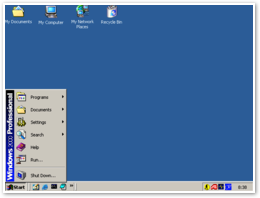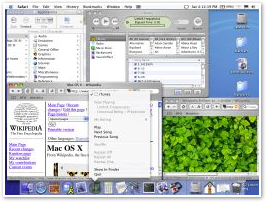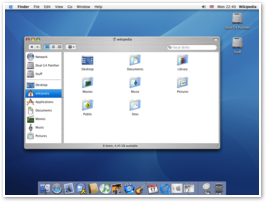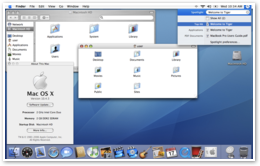





How much does it cost to maintain Windows and Mac OS X? Since Apple has released five times as many major updates and over fifteen times as many minor updates to Mac OS X since 2000, you might not have guessed that Windows actually costs users five times as much to keep up to date!
How will software pricing affect sales of Apple's upcoming Leopard and Microsoft's Vista? Here's a historical comparison of professional desktop operating systems from both, leading up to a future outlook for how Microsoft’s significantly more expensive platform will affect new computer sales in 2007.
I've written before about how people prefer to spend money on hardware and have expectations of getting their software for free. Apple employs this idea to entice users to buy new hardware. New Macs ship with a free copy of iLife apps, which some industry pundits have valued at $350 in comparable PC software. New Xserves include Mac OS X Server, which is $500 to $1000 as a standalone product.
However, in this article, I’ll ignore the software Apple bundles with new Macs and focus only on the actual costs related to keeping the OS up to date, both for Macs and Windows PCs. That includes retail operating system software updates and associated costs.
New Software on Old Hardware
Clearly, Apple wants to encourage users to buy new hardware, not just upgrade their software. At the same time, each successive major version of Mac OS X has brought significant speed improvements to Mac users’ existing hardware. Here's a look at how much it costs to stay on the bleeding edge, over the last seven years since 2000, based on my experience as a user of both Macs and Windows.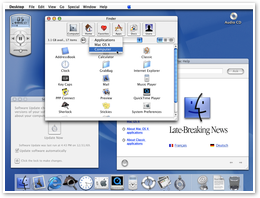

As an ADC member during the development of Rhapsody, I worked with the developer previews of Rhapsody and Mac OS X. These ran blazingly fast on even the archaic hardware of the late 90's, which is no surprise given that NeXTSTEP was designed to run well on 40 Mhz 68030 processors from nearly half a decade prior.
Apple made significant changes to Rhapsody in order to deliver a new product that would fit the needs of the market. These changes revamped and modernized every corner of Mac OS X, and initially resulted in a much slower system. All that brand new code was in need of a lot of optimization.
By the end of 2000, Mac OS X was just getting ready for its Public Beta release while the professional PC world was migrating to Microsoft's Windows 2000.
Mac OS X vs. Windows 2000.
I found the first commercial version of Mac OS X fun to check out in 2001, but not very practical to use for real work. It came included as an alternate boot install on my 400 MHz Titanium Powerbook.
Toward the end of 2001, Apple released the next major revision, 10.1. It was significantly improved, but still wasn't ready for mainstream use. Apple provided copies free for anyone who already had the original release.
Of course, anyone using Mac OS X in 2001 likely just found it installed on their new Mac. Since there wasn't much native software available for Mac OS X yet, there was little market for the product as a retail box.
Prior to Mac OS X, Mac users generally expected free updates of the Mac System Software. Throughout the 90's, Apple tried to convert their System Software into a retail product, with little success. Apple expended a lot of effort in trying to sell System 7 as a paid upgrade, and created a bundled set of add on software called System 7 Pro. Users largely just found copies of the software instead.
After the NeXT takeover, Apple stepped up efforts to productize the OS, and released minor updates to the languishing System 7 as Mac OS 8 and 9. The real efforts, however, were directed at delivering a version of Mac OS X that Mac users would pay money for, in order to support its development. It wasn't until Jaguar that Apple had an operating system that it could sell in serious quantity.
In contrast, Microsoft's entire business was built on selling its operating system: bundled with new PCs, licensed in bulk to businesses, and at retail. Apple wanted into the same game, because ongoing software development for their own platform was getting difficult to subsidize as the hardware market got more competitive.
2000-2001
-
•Apple delivered seven free updates to Mac OS X, but it was still not yet ready for prime time.
Cost: $0, although early adopters could pay $129 to try it out on their old beige Mac. -
•Microsoft delivered four service packs for Windows 2000, which was more stable and professional than either Mac OS.
Cost: $0 for PCs delivered with Windows 2000 Workstation, or $299 retail.
In 2002, Apple released 10.2 Jaguar, the first version that really allowed users to leave Mac OS 9 and begin using Mac OS X full time. While the 10.2 Finder lacked the snappy, solid feel of OS 9, it outperformed the Classic Mac OS in many other ways. it turned my first generation TiBook into a whole new machine. At a suggested retail of $129, or around $100 mail order, Jaguar was well worth the upgrade.
At the time, I was also using Windows 2000 on my IBM ThinkPad. I liked Windows 2000; it didn't capture the interface richness of the Mac, but it was productive and really demonstrated how far behind Apple had slipped on a technical level.
Applications rarely crashed, and when they did stop responding, it was a simple matter to kill them and keep going. It was a business OS, and didn't support many of the DOS based games that were designed to run on Windows 95/98/Me, but those features weren't important to me on my PC laptop.
Microsoft released Windows XP in 2001. However, a lack of any compelling real need for its new features, along with the steep $199 upgrade fee for the Pro version (required for use on a business network) kept me from upgrading immediately. The majority of users upgrading to XP, like Mac OS X users prior to Jaguar, simply found it installed on their new PC. 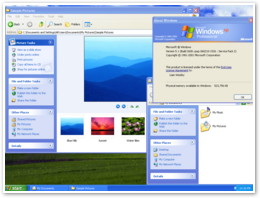

I was using XP on other systems I managed, and found the new "Fisher Price" Luna look annoying. Rather than Windows 2000's sleek minimalism, XP tried to be cute and fancy. Icons adopted a new rendered look similar to the one shown off for Apple’s aborted Copland or the BeOS, and common Explorer windows attempted to present the system as if it were a series of web pages. With existing software, XP just looked inconsistent and top heavy.
Apple released eight minor version updates to Jaguar for free, along with various other security and driver updates.
Microsoft delivered one service pack for XP, which included support for USB 2.0, Tablet PCs, and what they were calling "Freestyle PCs," which were the first stab at media center features. Win XP SP1 also changed activation to kill off bootleg copies, and delivered upon the monopoly trial's consent decree that insisted that Microsoft allow users to chose an alternative browser, email client, media player, and Java VM.
2002
-
•Jaguar plus 8 free updates from Apple, and many security patches.
Cost: $129. -
•1 free update from Microsoft for XP, several security patches.
Cost: $0 to users like me who passed on XP
By end of the following year, Apple delivered Panther 10.3 as the next major revision to Mac OS X. Panther delivered another major jump in performance, and introduced a new set of flashy features as well as invisible new features for developers and administrators.
I received Panther with a new, first generation PowerMac G5, as well as buying an update for my Powerbook. Having spent $200 on Mac OS X upgrades, I broke down and bought a Windows XP upgrade as well.
At around the same price of my two Mac upgrades, I was less impressed at the upgrade on my ThinkPad. Windows XP was stable, but felt like a minor upgrade. It certainly didn't give me the feel of new hardware the way Mac OS X updates had. If anything, the extra interface fluff just gave my ThinkPad more to do, without really being useful to me.
The real value in Windows XP came from its improved support for new hardware, particularly the Tablet and TV-centric features that Microsoft imagined would be the next step for PCs. XP also broadened support for gaming and consumer devices that had been lacking on the NT/2000 platform, so it was more of an upgrade for Windows 95/98/Me users.
This made Windows XP similar to Mac OS X, in that both brought new stability to an existing, aging platform by replacing much of the old system with a superior foundation: Windows XP migrated DOS-based Windows to NT, while Mac OS X migrated the Mac OS to NeXT.
By the end of 2003, Microsoft had missed their initial ship date for Longhorn, the next update to Windows XP. The company had started work on Longhorn prior to the release of XP, but had nothing to show for it after three years. At WinHec 2003, Microsoft announced the new Longhorn was delayed but would ship in early 2005.
In addition to development troubles with Longhorn, mounting security issues with Windows XP required Microsoft to focus on security for its existing product. Microsoft struggled to finish XP Service Pack 2, but didn't deliver it in 2003 either.
Microsoft did ship a new version of Windows XP called Media Center Edition, a further refinement of XP's Freestyle concept. MSE includes an application providing TV and DVR support, but is not a new operating system. Meanwhile, Apple released nine free updates to Panther.
2003
-
•Panther, plus 9 free updates from Apple, and many security updates.
Cost: $129. -
•0 services packs for Windows XP, many security updates
Cost: $199 upgrade, $299 new; $100 less for limited Home edition.
Tiger vs XP
Microsoft announced in 2004 it would scrap four years of existing efforts on Longhorn and start fresh using the codebase for Windows Server 2003. The restated "early 2005" timeframe was pushed out to the second half of 2006. The Wall Street Journal reported that Microsoft executives had realized by then that the existing Longhorn project was “not going to work.”
"Longhorn was irredeemable because Microsoft engineers were building it just as they had always built software. Throughout its history, Microsoft had let thousands of programmers each produce their own piece of computer code, then stitched it together into one sprawling program. Now, Mr. Allchin argued, the jig was up. Microsoft needed to start over."
Microsoft also committed to fixing the now embarrassing security issues with XP and finally shipped the second XP service pack. It provided a Security Center that nagged users to buy virus protection, and clamped down XP's open ports with a software firewall.
Meanwhile, Apple shipped Tiger 10.4 as a major new release, and has issued seven free updates since. The latest version of Mac OS X delivered many of the features promised for Longhorn, which had been officially named Windows Vista.
Core features of Vista were pruned away in attempts to just deliver something. The WinFS concept of a database oriented file system was scrapped entirely, and plans for Palladium Trusted Computing, an ultra secure architecture designed to turn the PC into a home appliance controlled by big media, was similarly put on hold.
After missing the 2006 goal, Microsoft restated the release for Vista again, to early 2007.
Meanwhile, Apple announced new features for the upcoming Leopard 10.5, but left other details under wraps. Leopard plans to ship in a timeframe similar to Vista, in early 2007. If Microsoft hasn't been able to ship anything for desktop users after seven years of development, why is Apple being so secretive about Leopard's feature set?
At this point, does it make any sense that Microsoft could substantially copy any Leopard features for inclusion into Vista, given that the company is already struggling to deliver their existing product? The most obvious answer is no. In a future article, I'll look at what's still top secret in Leopard, and why. But first, take a look at the cost comparison for keeping current as a Mac or Windows user over the last half decade.
2004-2006
-
•Tiger, plus 7 free updates from Apple and many security updates.
Cost: $129. -
•One new service pack for Windows XP and many security updates.
Cost: $0.
2000-2006: Seven Years of Operating System Upgrades
In retrospect, the cost of operating system upgrades is fairly minimal compared to the utility and performance they provide. Although Microsoft charges twice as much for Windows XP, a more significant factor is the external fees related to working around Window's security problems.
Maintaining a Windows install is like owning an aging, imported car: the initial sale price pales in comparison to its ongoing maintenance costs. Here’s an outline showing how Windows costs users over five times as much as Mac OS X. These numbers aren’t hypothetical, but rather are based on my own experience, and those of my clients.
A Mac user since 2000, upgrading to each new version of Mac OS X:
-
•$300 in operating system updates, or nearly $400 if purchased at full retail.
-
•Three major new releases that significantly improved performance of the same hardware and introduced new apps.
-
•Thirty one regular minor updates with bug fixes and new features, in addition to many security updates.
-
•No antivirus needed
-
•No spyware cleaning needed
-
•Total cost of maintaining Mac OS X software: about $50 a year, or around $350 since 2000. (Reports of “$750” were a mix of Truthiness and bad math.)
A Professional Windows user since 2000, upgrading at the one opportunity available:
-
•$200 upgrade to XP Professional, or $300 for a new retail version.
-
•One major new release that improved reliability but not the performance of old hardware.
-
•Two minor service pack updates focused on bugs and security features, and around fifty security patches since SP2.
-
•Seven years of AntiVirus 2000 $50, plus $30 for six annual updates = $230
-
•Spyware and security cleaning by Geek Squad: a $200 annual servicing over seven years = $1400
-
•Total cost of maintaining Windows software: over $250 a year, or more than $1800 since 2000.
The much lower cost of Mac OS X and Apple’s far more frequent releases of free updates will be a major selling point next year for users comparing the purchase of a new Mac with Leopard over a new PC with Vista.
Additionally, while Leopard will likely continue to run on the same Macs as Tiger (anything modern enough to have built in Firewire), Vista will require a new PC to run, likely something from the last year and a half. 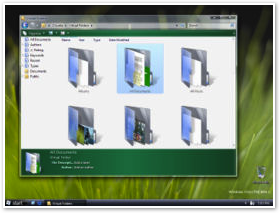

For home users, Vista won’t even include the new Vista Aero look unless they upgrade beyond the Home Basic version to buy Home Premium. There are six versions of Vista in all, differentiated by artificial product limitations. They ship on the same DVD, and users will be able to pay directly from Windows to unlock the features of more premium versions.
Will users see the value in paying over three times as much for Vista over Leopard? With the average price of consumer PCs dropping this year to $744, will users be excited to pay around half the cost of a new PC to buy Vista Ultimate Edition software?
That’s an idea glossed over by pundits throwing around simple market share figures. The valuable portion of the huge worldwide PC market that matters is actually very small. Dell and HP have a lot of market share, but they also carry the burden of supporting the unprofitable, low quality, but high volume majority of the market.
Apple’s 2.2% worldwide share is entirely made up of premium users, because Apple doesn’t even sell low-end, loss leader, disposable PCs to pad its market share numbers. How much more of the premium market will Apple grab with Leopard and its new Macs? I have predictions coming.
This Series

| | Comment Preview
 Read more about:
Read more about:

 Send |
Send |

 Subscribe |
Subscribe |
 Del.icio.us |
Del.icio.us |
 Digg |
Digg |
 Furl |
Furl |
 Reddit |
Reddit |
 Technorati
Technorati
Click one of the links above to display related articles on this page.
Windows 5x More Expensive than Mac OS X
Tuesday, August 15, 2006





Ad






